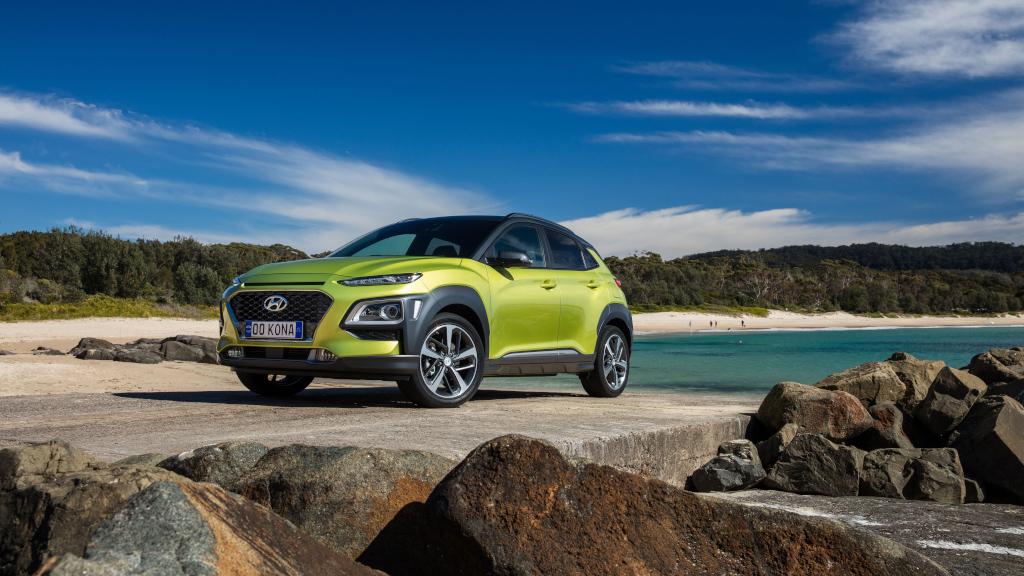It is official – Hyundai plans to introduce its funky and progressive new Kona – named after the western district, the leeward or dry side of the island of Hawaii – to South Africa by October this year.
The subcompact Kona will fit in the small gap between the Creta and Tucson in the SUV line-up of the Korean manufacturer, but with its cool and confident appearance, the Kona will give it a completely new character.
Designed to take on the Toyota C-HR, Nissan Juke, Honda HR-V, and expected newcomers, such as the Volkswagen T-Cross and Stonic from sister company Kia, the expressive front of the Kona is characterised by the signature cascading grille of Hyundai, with LED daytime running lights positioned on top of the LED headlights, giving it a sleek and confident appearance.
Its bold front and rear emphasises its wide stance and voluminous body styling, while 18-inch alloy wheels, a shark fin antenna, two-tone roof, and the choice of ten distinctive exterior colours that offer 27 individual combinations, further contribute to the bold character of the Kona.
Winning interior design
The award-winning interior design of the Kona reflects the exterior theme featuring smooth, contoured surfaces on top of the instrument panel contrasting with the dark painted parts, and it can be personalised with three distinctive colours: Orange, Lime, and Red. The colour accents are featured on the air vent surrounds, around the gearshift, the engine start button ring, the stitching on the seats, and the steering wheel. The floating screen of the optional eight-inch navigation touchscreen allows the driver to stay focused on the road, while exclusive seats with optional three-step ventilation and a heated steering wheel offers passengers more comfort. The Kona offers front-seat legroom of 1,054 mm and 880 mm in the rear and has a luggage capacity of 361 litres.
It also features a combiner head-up display and optional eight-inch infotainment system that integrates navigation, media, and connectivity features, supporting Apple CarPlay and Android Auto. Kona offers a premium sound system by Krell featuring eight speakers.
With Hyundai Smartsense and safety features, including Forward Collision Warning, Forward Collision-Avoidance Assist with pedestrian detection, Lane Keeping Assist (standard), High Beam Assist with Static Low Beam Assist, Driver Attention Warning (standard), Blind-Spot Collision Warning, and Rear Cross-Traffic Collision Warning, the Kona is one of the safest vehicles in the B-segment, proven by the five-star safety rating from Euro NCAP.
Petrol drivetrains
In Europe the Kona is available with the new Smartstream 1.6-litre diesel engine (delivering either 85 kW or 100 kW), a 130 kW 1.6 T-GDI petrol engine, or an economical 1.0-litre T-GDI three-cylinder turbocharged petrol engine, delivering 88 kW of power and 172 Nm of torque.
The 1.0-litre Kappa turbo petrol, with a combined fuel consumption of 5,7 l100 km and CO2 emissions of 129 g/km, is earmarked for South Africa, as well as the 2.0-litre MPi petrol engine (also used in the Tucson), delivering 110 kW and 180 Nm of torque, while the 1.0-litre engine is mated to a six-speed manual transmission, the two-litre models will also be available with a seven-speed dual-clutch transmission. In combination with the 7DCT, the new Kona offers three drive modes: ECO, Normal, and Sport.
No diesel derivatives will be offered locally, and while the Kona is available with on-demand four-wheel-drive overseas, South African models will be front-wheel drive only.
While pricing has not yet been released, the Kona will probably cost between R330,000 and R400,000, considering the price tags for the C-HR (R336,000 to R422,100), Juke (R306,500 – R411,900), and HR-V (R347,600 – R411,400).
– Ferdi de Vos


